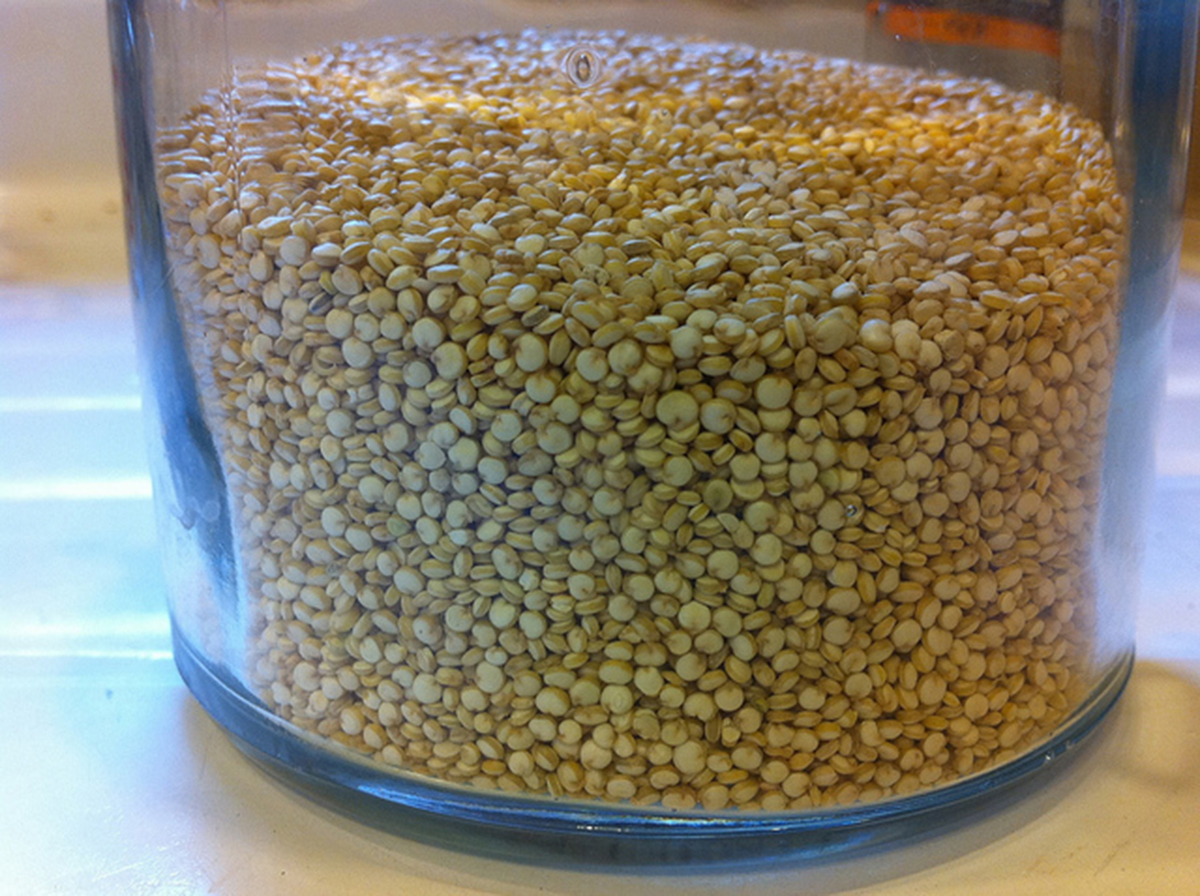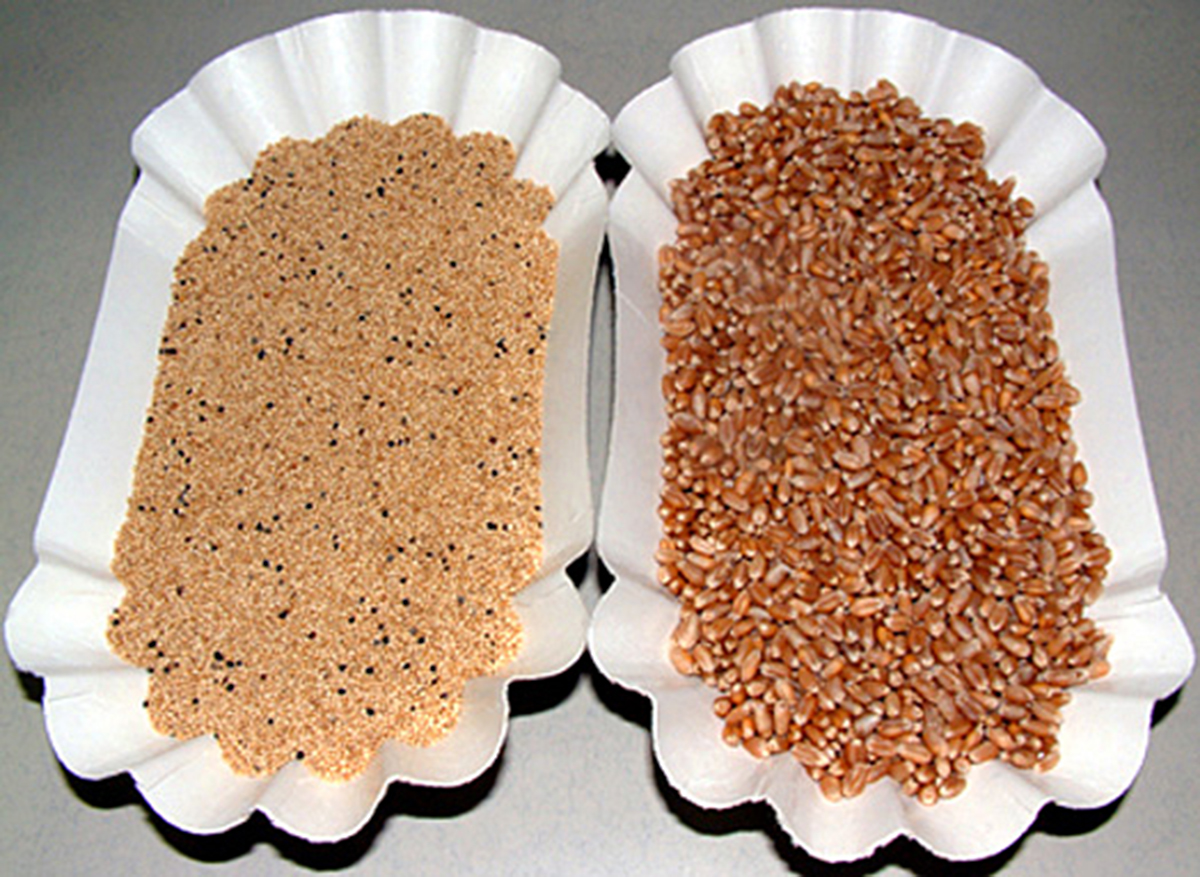Table of Contents
Popular in ancient cultures, especially in Latin America, pseudo-cereals have only recently been rediscovered as having excellent nutritional qualities. While interest in these so-called pseudo grains is on the rise, cultivation is still dwarfed globally by the “true” cereal grains.
According to Berghofer and Schoenlechner, even though there is considerably more interest in amaranth and quinoa (see photograph above) than there was before, cultivation remains low, and, as they point out, amaranth doesn’t even make it onto the United Nations’ Food and Agriculture Organization (FAO) production data statistics. However, buckwheat, which fell out of favor centuries ago due to the intense cultivation of other cereals, has already made a comeback in many parts of the world, including China and Russia – primarily, they say because it is gluten-free. Buckwheat also has the potential to be processed in a similar way to wheat.

As interest in pseudo-cereals grows, there is a small but relatively fast-growing body of antagonism and opposition to true cereal grains, especially wheat. This is largely due to an increasing awareness of the importance of how nutrition is so closely linked to health and wellness.
The photograph, below, shows amaranth and wheat grains, left and right respectively.

How Health and Wellness Affect Cereals and Pseudo-Cereals
Faced with horrifying statistics relating to obesity, diabetes and other life-threatening diseases, Americans, along with health-conscious men and women throughout most of the Western world are looking more carefully at what they eat and drink, and the lifestyle they follow. There’s a mountain of literature to read, including diets and nutritional handbooks. While these differ in terms of methods and advice, one thing that seldom differs is the need to eat just enough “real” food to provide what our bodies need to thrive at a healthy weight. Something else many contemporary diets have in common is the need to maintain healthy, normal blood sugar levels.
While there are many contradictions between the ideas offered in them, books I have found particularly interesting include:
- Wheat Belly by US cardiologist William Davis, an international best seller that advocates eliminating so-called healthy whole-grain wheat from our diets to regain our health and lose weight
- The Real Meal Revolution by South African exercise and sports scientist, Prof Tim Noakes (also a long-time marathon runner) in collaboration with a nutritionist, and two other athletes (one a chef and the other a restaurateur), whose low-carb high-fat diet bans any types of grains, including pseudo-grains
- The Holford Low-GL Diet Made Easy by British nutrition expert Patrick Holford whose diet allows grains, including wholemeal bread and pastas as well as pseudo-grains, but disallows white bread and other high-GL foods that raise blood sugar levels too quickly for the body to be able to cope
Dr Davis totally condemns wheat, but he also draws attention to the fact that “real wheat” grown centuries ago is nothing like the wheat geneticists have created. Not only are the new strains considerably smaller than older types, but new-type wheat won’t survive without pest control and modern forms of fertilization. Yields are much higher and better for baking! At the end of the day he refers to “a good grain gone bad” – a disruptive food that makes people both sick and fat.
Tim Noakes, formerly an avid carbo-loader who ran many successful marathons and ultra-marathons, who changed his tune after developing diabetes, and literally gave up all carbohydrates – because of the insulin response they elicit. For this reason, he says that ALL grain-based food should be avoided, including “wheat, oats, barley, rye, amaranth quinoa, teff etc” and all flours made from grains, as well as all forms of bread.
Patrick Holford, on the other hand, draws attention to the need to avoid wheat and grains that contain gluten if you are sensitive to them. If not, he says some grains may be eaten as long as carbohydrates are not refined, blood sugar is balanced, and the total GL (glycemic load as opposed to the better know GI or glycemic index) is balanced.
Ironically, though I now eat a primarily low-carb high-fat diet, and am at my ideal weight for the first time in 30 years, the only one of these three diets I ever actively followed was Patrick Holford’s – and it did work. While I eat less fat and more carbs than Noakes advocates, I follow his regime to only eat when hungry; and in contradiction with the Real Meal Revolution, I tend to eat lots of small amounts as dictated by Holford. I try to avoid wheat, as suggested by Davis, and I have increased my exercise by more 100 percent.
But none of this is based on science, so what does published research tell us?
What Research Tells Us
Much of the research relating to cereals and pseudo-cereals relates to allergies and disease, particularly the need for food ingredients that do not contain gluten. This is fired largely by the fact that coeliac (or celiac) disease demands a total forever-after elimination of any foods that contain gluten, and the fact that most gluten-free products are considered to be of a poor nutritional value.
In an Irish study released in 2009, amaranth, buckwheat and quinoa were studied to see if they could be used as healthy ingredients to improve the nutritional quality of bread that was free from gluten. The results showed that they were indeed a healthy alternative for gluten-free products.
In another study released the same year, a Chilean researcher looked more specifically at quinoa because of its recognition as “a complete food.” He found it had “remarkable nutritional qualities,” not only because of its 15 percent protein content, but also because it has a very good amino acid balance plus vitamins and minerals and other compounds with possible nutraceutical benefits. Additionally, it is what he called “an oil crop” that contains omega-5 and vitamin E. Ultimately he found it to be “a promising alternative cultivar.”
The US Food and Drug Administration (FDA) standard defines “gluten-free” as a food that doesn’t contain “wheat, rye, barley or their crossbred hybrids” or an ingredient that is derived from “a prohibited grain” that has been processed to get rid of the gluten content. It also states that not more than 20 ppm of gluten is allowable in the grain or ingredient.
An Italian study published in 2010 looked at the nutritional state of celiac patients including common nutrient deficiencies, the nutritional and safety elements of gluten-free diets, allowable foods, and more importantly, the characteristics of pseudo-cereals and some other “minor cereals” including teff and millet, which the study found to be “a promising area” for sufferers.
A Spanish study published in 2013 focused on gluten-free diets and tested “alternative cereals” that might be tolerated by patients suffering from celiac disease. The motivation was spurred by the lack of alternative food products and treatments. Researchers concluded that more controlled clinical studies were necessary to support the validity of including pseudo-cereals in the diets of those with celiac disease was inconclusive.
Another study, carried out in Serbia, and published in 2013, compared the sugar components of pseudo-cereal (specifically from amaranth and buckwheat) and more usual cereal flour made from wheat. The researchers’ aim was to find a new method that would enable them to detect the “flour origin” of cereals and pseudo-cereals for safety purposes. The study was successful.
READ Could Your Breakfast Cereal Be Sabotaging Your Weight Loss Plans?
A study undertaken in Portugal in about 2014 showed that pseudo-cereals are a rich source of amino acids and could likely be a successful alternative to rice for gluten-free diets. The study also showed that the protein content in the three pseudo-cereals discussed were high.
So pseudo-cereals are looking good.
Genetic Modification of Pseudo-Cereals
A global leader in cereal grain science research and education, AACCI not only categorizes the ancient pseudo-grains with “the big four” cereals – wheat, rice, maize and barley – the organization also believes that the industry must modify these plants genetically to improve yield and quality. As the fight against Monsanto and genetically modified food intensifies, this is unlikely to do the pseudo-grains much good.
In the meantime, while it is still mandatory for companies to label genetically modified foods GMO, read the labels before you buy. If the so-called Safe and Accurate Food Labeling Act (dubbed the Deny Americans the Right to Know [DARK] Act) is voted into law, the value of pseudo-cereals versus wheat and other GMO cereals is surely going to be reduced.
- Wheat Belly by William Davis MD. Rodale Inc, USA 2011 & HarperThorsons UK 2014
- The Real Meal Revolution: Changing the World, One Meal at a Time by Prof Tim Noakes, Sally-Ann Creed, Jonno Proudfoot and David Grier. Quivertree Publications, Cape Town, SA 2013
- The Holford Low-GL Diet Made Easy by Patrick Holford. Piatkus Books Limited, London, UK 2006
- Pseudocereals – An Overview by E Berghover and R Schoenlechner. Department of Food Science and Technology, University of Natural Resources and Applied Life Sciences, Vienna, Austria
- projekt.sik.se/traditionalgrains/review/Oral%20presentation%20PDF%20files/Berghofer%20.pdf
- Cereal Grains and Pseudo-Cereals by David D Baltensperger. Encyclopedia of Food and Culture, Gale, Detroit, USA 2003
- . http://www.encyclopedia.com/doc/1G2-3403400119.html
- Prospects for genetic improvement of Ancient Grains
- www.aaccnet.org/meetings/Documents/2015Abstracts/aacci2015abs351.htm
- Urgent Call to Action: Stop the DARK Act! https://www.organicconsumers.org/campaigns/millions-against-monsanto
- Nutritive value and chemical composition of pseudocereals as gluten-free ingredient http://www.ncbi.nlm.nih.gov/pubmed/19462323
- Quinoa (Chenopodium quinoa Willd.): composition, chemistry, nutritional, and functional properties
- www.ncbi.nlm.nih.gov/pubmed/19878856
- Comparing sugar components of cereal and pseudocereal flour by GC-MS analysis http://www.sciencedirect.com /science/article/pii/S0308814613012405
- Protein content and amino acids profile of pseudocereals http://www.sciencedirect.com/science/article/pii/S0308814614017725
- Comparing sugar components of cereal and pseudocereal flour by GC-MS analysis by Marijana M Acanski and Djura Vujic, Food Chemistry Volume 145, February 2014 http://www.sciencedirect.com/science/article/pii/S0308814613012405
- The Gluten-Free Diet: Testing Alternative Cereals Tolerated by Celiac Patients http://www.ncbi.nlm.nih.gov/pmc/articles/PMC3820072/
- The Gluten-Free Diet: Safety and Nutritional Quality http://www.ncbi.nlm.nih.gov/pmc/articles/PMC3257612/
- Photograph of amaranth seeds and wheat grain courtesy of Maksim/wikimedia https://commons.wikimedia.org/wiki/File:Amaranth_und_WW.jpg
- Photo courtesy of Ross Cathrow: https://www.flickr.com/photos/maxpower/4903830895
- Photo courtesy of Ervins Strauhmanis: www.flickr.com/photos/ervins_strauhmanis/9545949677/
- Important notification about information and brand names http://www.steadyhealth.com/polices/terms-of-use#copyright


Your thoughts on this